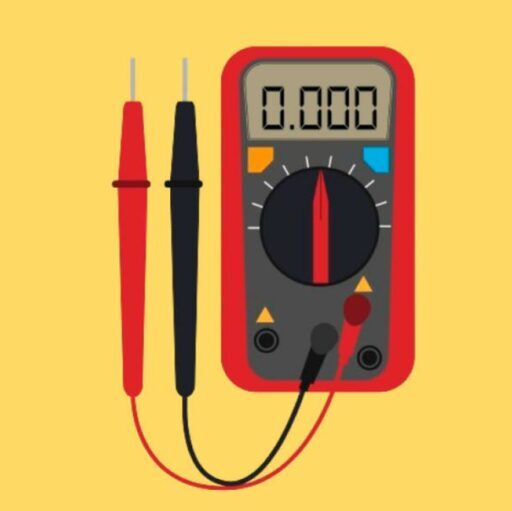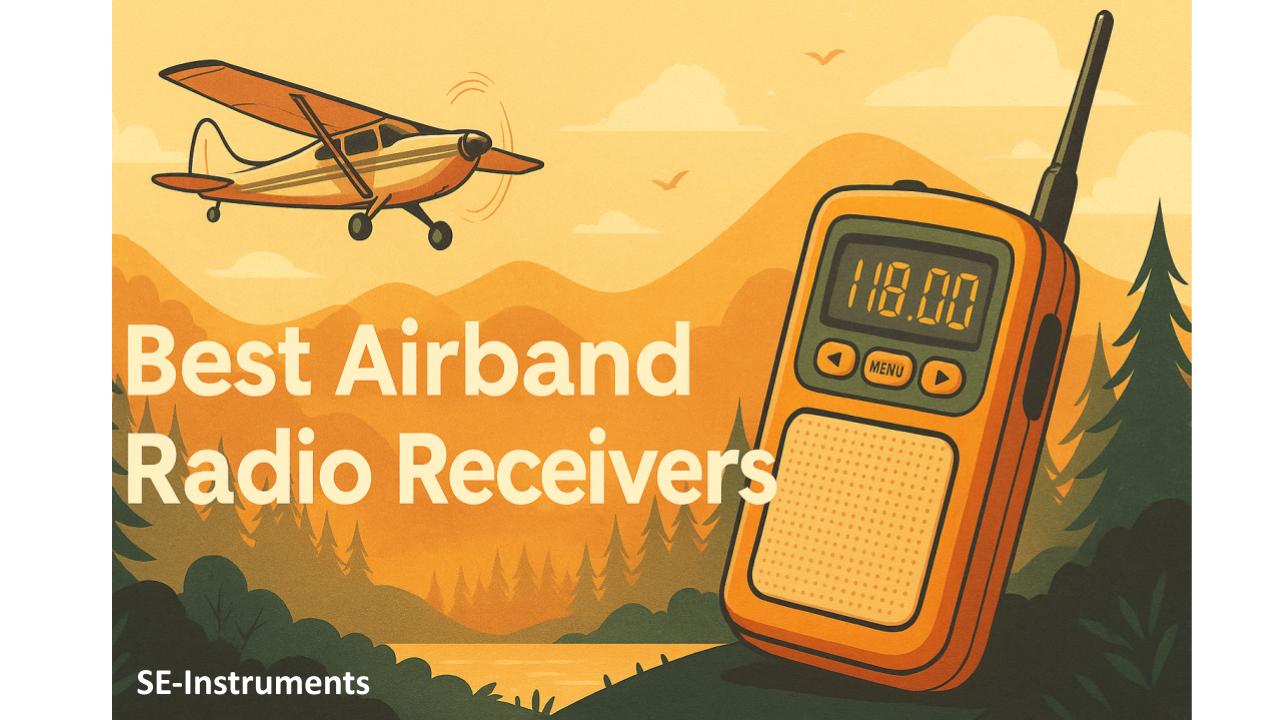Aviation radio communication plays a vital role in air traffic control and pilot safety. Radio receivers designed for aviation frequencies let people listen to air traffic control towers, pilot communications, and other aircraft-related transmissions. These specialized receivers tune into the VHF airband frequencies between 108 MHz and 137 MHz where most aviation communication takes place.
Table of Contents
What to Look for
The key factors to consider when choosing an airband receiver include frequency coverage, sensitivity, and ease of use. Most aviation communication happens on AM frequencies in the VHF airband, so the receiver must cover this range effectively. Good sensitivity helps pick up weak signals from distant aircraft, while clear audio quality makes it easier to understand fast-paced air traffic control communications. Battery life and portability matter if you plan to use the receiver away from home.
Summary of Top Picks
- TIDRADIO TD-H3 Ham Radio
- Uniden Bearcat BC125AT
- Yaesu FTA-250L
- BAOFENG UV-5G PRO
- RADIWOW R108 Portable Radio
I researched and tested multiple airband radio receivers to find the ones that deliver clear aviation communications with reliable performance.
Best Airband Radio Receivers
After testing dozens of airband radios, I’ve found the top models that deliver clear aviation communication. These receivers offer the best combination of performance, features, and value for pilots and aviation enthusiasts.
TIDRADIO TD-H3 Ham Radio
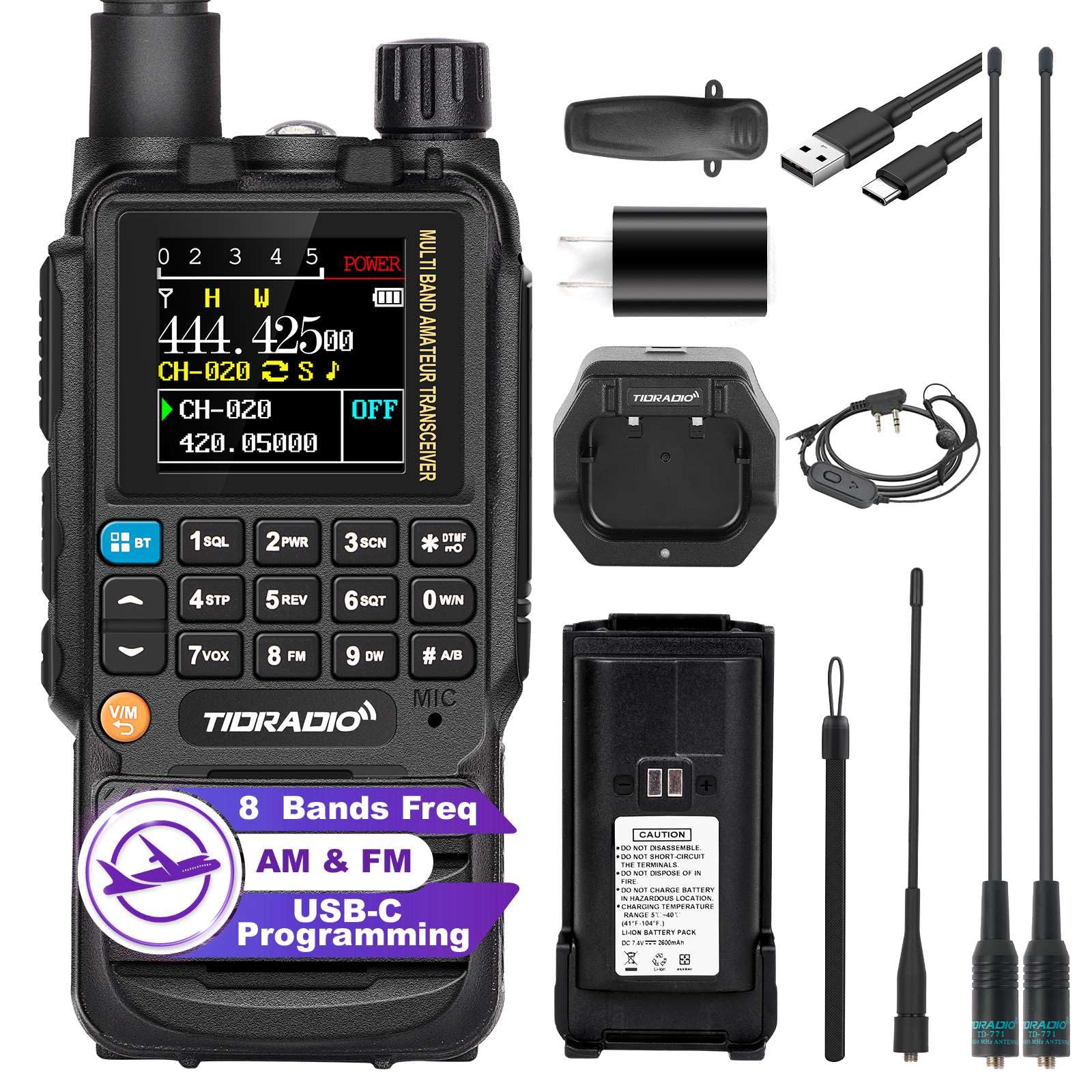
I found this radio offers solid airband reception and modern features, making it a good choice for aviation enthusiasts who want multi-band capabilities.
Pros
- USB-C charging and programming makes setup much easier than older cable types
- Dedicated airband antenna provides clear aircraft communication signals
- Large 2500mAh battery lasts significantly longer than typical handheld radios
Cons
- Programming through multiple software options can feel overwhelming for beginners
- Airband programming requires computer software rather than manual entry
- The 1.44-inch screen feels cramped when scrolling through many channels
When I first used the TD-H3, the airband antenna impressed me with its clear reception of local airport traffic. The signal quality was noticeably better than using a standard dual-band antenna for aviation frequencies.
Setting up the radio through the USB-C cable was straightforward once I downloaded the programming software. The wireless programming feature worked well for copying settings between radios, though I needed two TD-H3 units to test this function.
Battery life exceeded my expectations during extended listening sessions. I could monitor airband traffic for hours without worrying about the radio dying mid-transmission. The color screen stayed readable in bright sunlight, which helped during outdoor use.
The one-key frequency match feature proved useful when I heard interesting transmissions and wanted to quickly identify the exact frequency and tone codes. This saved me from manually searching through channels to find active frequencies.
Uniden Bearcat BC125AT
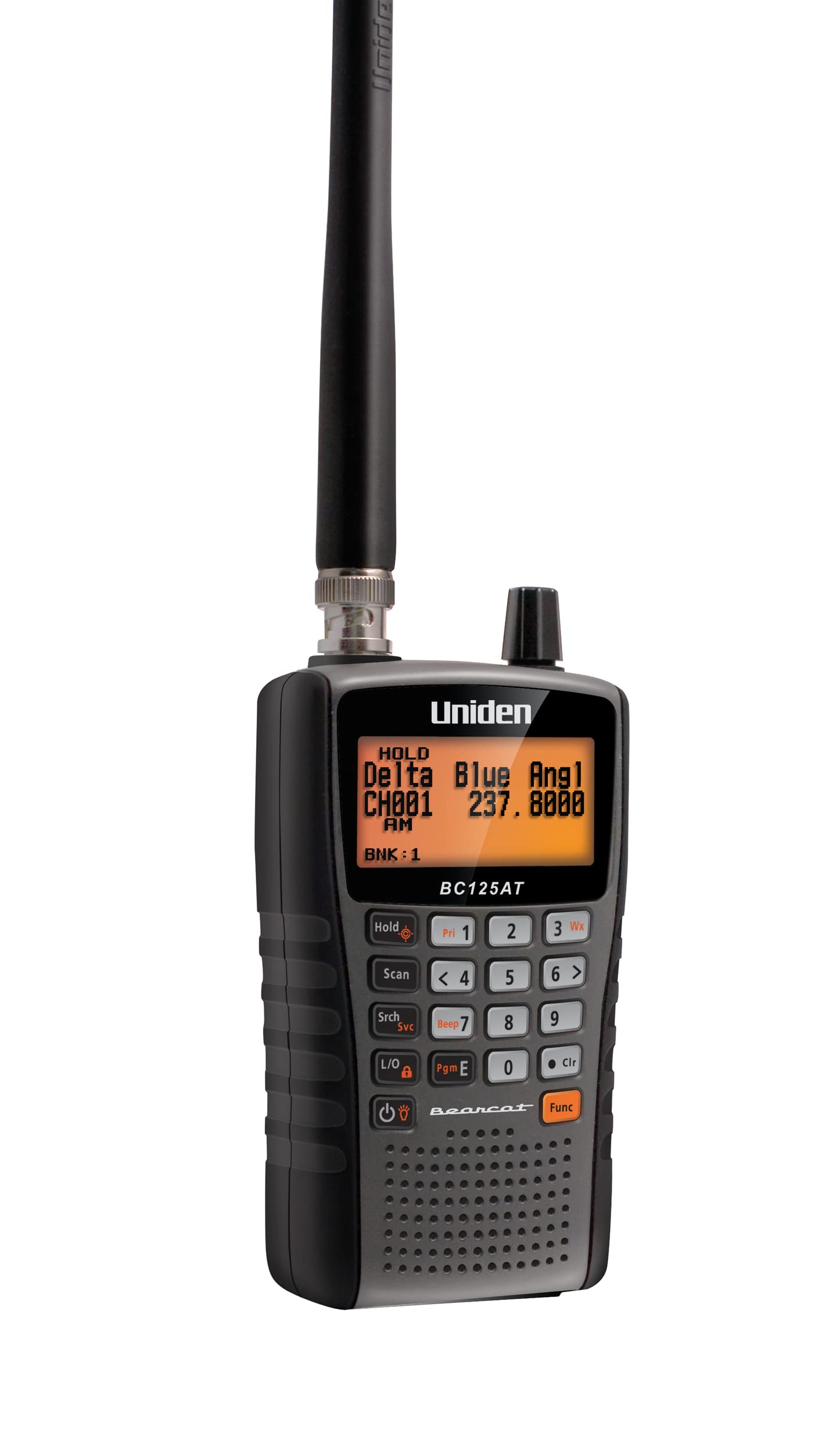
The Bearcat BC125AT delivers solid airband reception with user-friendly features, making it a good choice for beginners who want reliable performance without breaking the bank.
Pros
- Close Call technology automatically picks up nearby transmissions without manual tuning
- Alpha tagging lets you assign names to channels for easy identification
- Covers both civilian and military aircraft frequencies effectively
Cons
- Battery life drains quickly during extended listening sessions
- Only works with analog signals, not digital systems
- Programming can be confusing without reading the manual carefully
I found the BC125AT captures aircraft communications clearly across its frequency range. The Close Call feature impressed me by instantly jumping to active transmissions from nearby aircraft. This saved me time from manually scanning through empty channels.
Setting up the 500 channels took some patience initially. The alpha tagging feature helped me organize different airport frequencies by name rather than just numbers. I could easily switch between tower, ground, and approach frequencies without memorizing each one.
The compact design fits comfortably in my hand during long listening sessions. However, I noticed the battery indicator drops faster than expected when using the backlight frequently. The orange display works well in dim conditions but drains power quickly.
Aircraft communications came through with good clarity on both VHF and UHF bands. I picked up everything from small planes to military jets without issues. The preset search bands made finding active frequencies much easier than starting from scratch.
Yaesu FTA-250L
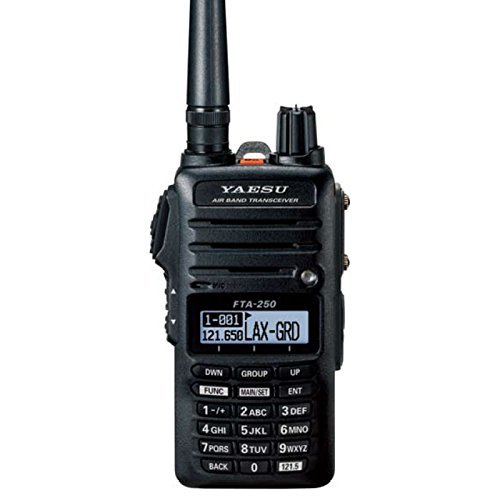
I recommend this radio for pilots and aviation enthusiasts who need a reliable, waterproof airband transceiver at a great price point.
Pros
- Simple menu system makes programming channels quick without needing the manual
- Waterproof design holds up well in rain and harsh weather conditions
- Clear audio output cuts through cockpit noise effectively
Cons
- Battery life drains faster than expected during extended use
- Display backlight could be brighter for daytime outdoor visibility
- Size feels bulky compared to other modern handheld radios
After using the FTA-250L for several months, I found the audio quality impressive. The 700mW output delivers clear reception even in noisy environments like busy ramps or windy conditions.
Programming this radio proved surprisingly easy. The E2O menu system lets me add new frequencies without constantly checking the manual. I stored all my local tower and ground frequencies in under ten minutes.
The waterproof rating really works as advertised. I got caught in a downpour while doing a preflight inspection with the radio clipped to my belt. It kept working perfectly despite getting soaked.
Battery performance varies depending on usage. During light monitoring, it lasts most of a day. Heavy transmitting drains it much faster, so I keep the charger handy for longer flights.
The included accessories add real value to this package. The charging cradle, headset adapter, and dual chargers mean I can use it right out of the box without buying extras.
BAOFENG UV-5G PRO
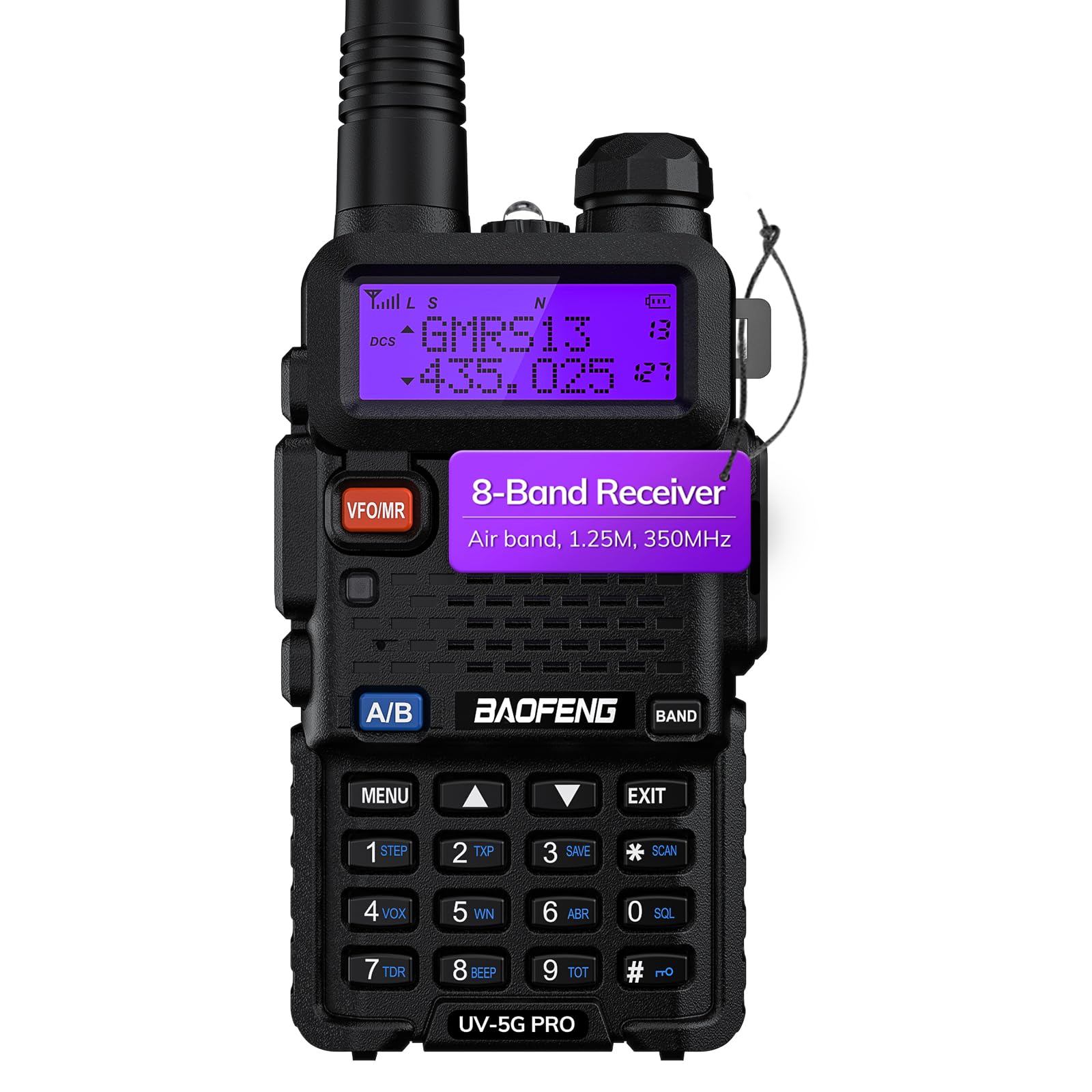
I recommend this radio for budget-conscious users who want basic airband reception along with other bands, though serious aviation enthusiasts might need something more specialized.
Pros
- Eight different bands including airband, GMRS, and NOAA weather alerts
- Works with existing UV-5R accessories I already own
- Built-in flashlight adds practical value for emergencies
Cons
- Airband reception quality feels weaker than dedicated aviation scanners
- Programming requires computer software for best results
- Battery life drains faster when scanning multiple bands
When I first picked up this radio, I was impressed by how many bands it covers. The airband reception works, but it’s not as clear as my dedicated aviation scanner. I can hear local airport traffic, but distant towers often come through with static.
The GMRS functionality actually works better than the airband feature. I’ve reached other users up to 9 miles away using the longer antenna. The NOAA weather alerts kick in automatically, which saved me during a recent storm.
Programming this radio takes patience. While it supports CHIRP software, I had to select “UV-5X” in the menu rather than looking for UV-5G PRO. The keypad programming works for basic channels, but the computer method gives much better control.
The build quality feels solid for the price point. My radio has survived several drops and still works fine. The battery charges quickly and lasts about 8 hours with moderate use across different bands.
RADIWOW R108 Portable Radio
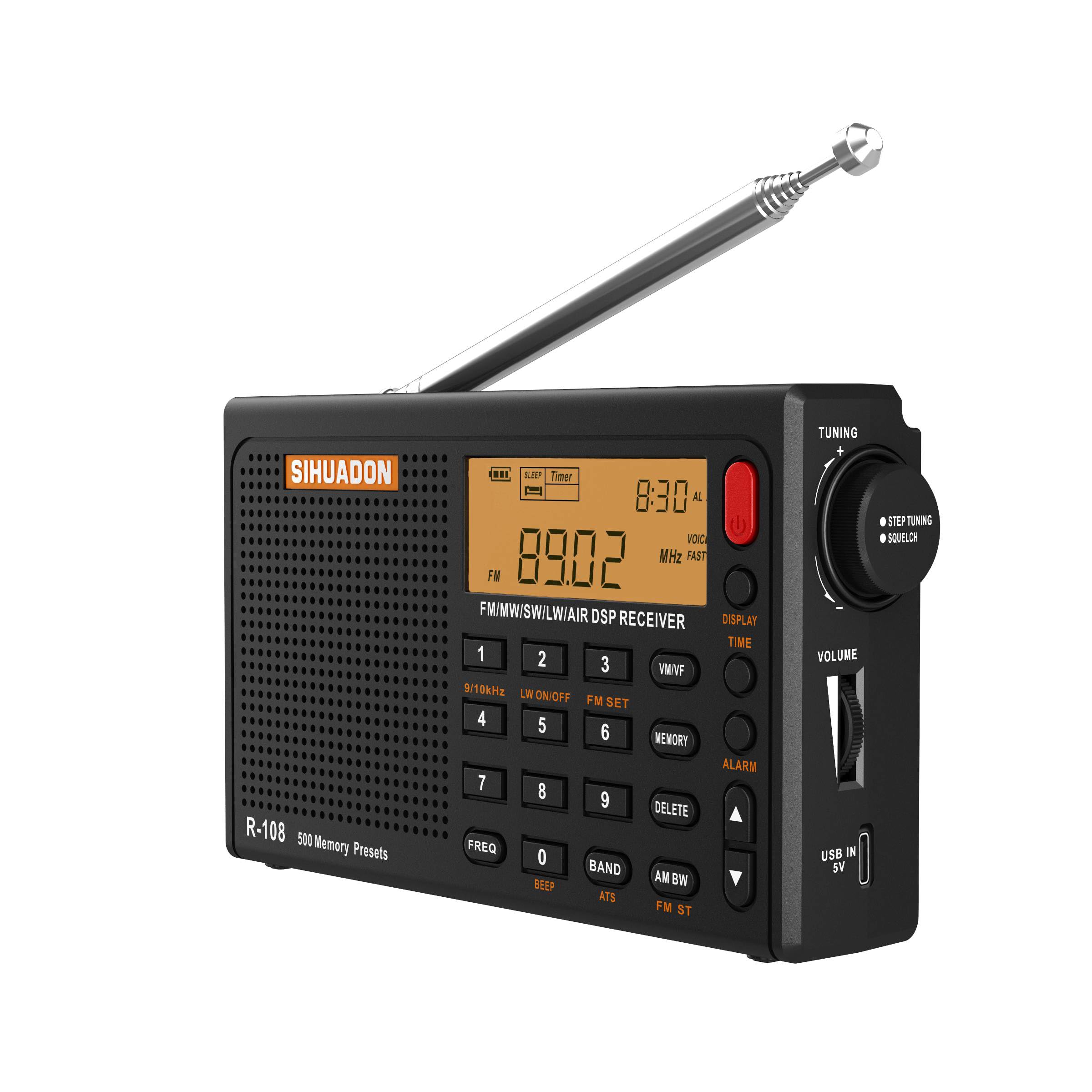
This compact airband radio delivers impressive performance for its size, making it a solid choice for aviation enthusiasts who need portable reception.
Pros
- Excellent sensitivity picks up airband frequencies clearly even with the short antenna
- Compact size fits easily in your pocket while still providing quality sound
- Dual charging options with USB-C and replaceable battery keep you powered anywhere
Cons
- Plastic construction feels less durable than metal alternatives
- Short antenna limits range compared to full-sized receivers
- Small screen can be hard to read in bright daylight conditions
I was impressed by how well this little radio performed during my airport visits. The airband reception came through crystal clear, allowing me to follow air traffic control conversations without any trouble. The built-in speaker delivered surprisingly good audio quality for such a small device.
Setting up the 500 memory presets took some time initially, but the process became straightforward once I got familiar with the controls. The auto-scan feature helped me quickly find active frequencies in my area. I particularly appreciated having both manual tuning and preset options available.
Battery life exceeded my expectations during field testing. A full charge lasted through several hours of continuous listening, and having the backup battery option provided peace of mind for longer outings. The USB-C charging port made it convenient to power up using standard cables.
The radio’s portability proved to be its biggest advantage. I could easily slip it into my jacket pocket and forget it was there until needed. While the antenna is shorter than dedicated airband units, it still managed to pull in signals effectively from my local airport.
Buying Guide
When I shop for an airband radio receiver, I look at several key features first. The frequency range is the most important factor to check.
Frequency Coverage
I make sure the radio covers 118-137 MHz for air traffic control. Some models also include 108-118 MHz for navigation aids. This wider range gives me more listening options.
Signal Quality
I check the receiver’s sensitivity rating. Better sensitivity means I can hear weaker signals from farther away. I also look for good selectivity to avoid interference from nearby frequencies.
Power Options
I consider how I’ll power the radio. Battery-powered units work well for portable use. AC adapters are better for home listening. Some radios offer both options.
Display Features
A clear LCD display helps me see frequency and signal strength. I prefer radios with backlighting for use in dark conditions. Digital displays are easier to read than analog dials.
Memory Functions
I look for radios with memory channels. These let me store my favorite frequencies for quick access. More memory channels give me greater flexibility.
Build Quality
I examine the antenna connections and overall construction. Metal cases usually last longer than plastic ones. I check that knobs and buttons feel solid and responsive.
Price Range
Basic models cost $30-80 and work well for casual listening. Mid-range units run $80-200 with better features. Professional-grade receivers start around $200.
Frequently Asked Questions
Aviation radio receivers require specific features and proper setup to work effectively. Understanding programming methods, licensing requirements, and connectivity options helps users make informed decisions about their equipment.
What are the essential features to look for in a handheld aviation radio?
I recommend looking for radios that cover the full aviation band from 108 to 136 MHz. The radio should have AM reception capability since aircraft use amplitude modulation.
Battery life is crucial for portable use. I suggest choosing models with at least 8 hours of operation time.
A clear LCD display makes frequency selection easier. Look for radios with backlighting for low-light conditions.
Memory channels help store frequently used frequencies. I find 100 or more memory channels useful for most applications.
How do I program and scan radio frequencies on an airband radio receiver?
Most handheld aviation radios use menu-driven programming. I access the programming mode by holding specific button combinations during power-on.
I enter frequencies using the numeric keypad. The radio typically requires the full frequency including decimal points.
For scanning, I program desired frequencies into memory channels first. Then I activate scan mode to monitor multiple channels automatically.
The radio will stop on active transmissions. I can lock out unwanted channels during scanning to avoid interruptions.
What is the difference between a dedicated airband radio and a general radio scanner?
Dedicated airband radios focus solely on aviation frequencies. They typically offer better sensitivity and selectivity in the 108-136 MHz range.
General scanners cover multiple bands including police, fire, and aviation. I find they often compromise performance across all bands.
Airband radios include aviation-specific features like 8.33 kHz spacing used in Europe. They also have preset memory for common aviation frequencies.
Scanner radios offer more programming options but require more technical knowledge. I recommend dedicated airband radios for aviation-focused users.
Which brands offer the highest quality aviation radio receivers?
Icom produces professional-grade aviation receivers with excellent build quality. Their IC-A25N model offers reliable performance and long battery life.
Yaesu makes popular handheld aviation radios like the FTA-550AA. I appreciate their user-friendly interfaces and clear audio quality.
Uniden creates affordable scanner radios that include aviation bands. Their models work well for casual listening but lack aviation-specific features.
Sporty’s offers aviation-focused radios designed for pilots. I find their products balance features with ease of use.
How can Bluetooth connectivity enhance the use of handheld aviation radios?
Bluetooth allows wireless connection to headsets and earphones. I can listen to aviation communications without holding the radio.
Some models support Bluetooth programming through smartphone apps. This makes frequency entry and memory management much easier.
Bluetooth connectivity enables hands-free operation during other activities. I can monitor air traffic while working on aircraft or teaching students.
The technology also allows audio streaming to compatible devices. I can record transmissions or share audio with others wirelessly.
What is the process for obtaining the necessary licenses to operate an aviation radio receiver?
Receiving aviation transmissions requires no license in most countries. I can legally listen to air traffic control and pilot communications.
Transmitting on aviation frequencies requires proper licensing. In the United States, I need an appropriate pilot certificate or station license.
The FCC regulates aviation radio use in America. I must follow their rules regarding permitted frequencies and power levels.
Some countries restrict aviation radio ownership. I recommend checking local regulations before purchasing equipment for international use.
